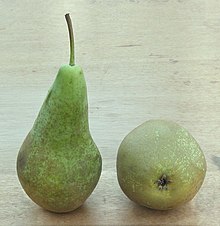Cultivation and production
The Conference pear adapts to a variety of conditions, and is widely grown in Europe. It thrives on land that is sunny, rich and not too chalky. In France, the production areas of this variety are mostly in the north (Loire, North Picardy) and the Alps (Savoie and the little Southern Alps). It is grown commercially in many areas of the United Kingdom and accounts for around 90% of UK pears. [1] [5]
Production will be enhanced by the nearby presence of pollinating varieties such as the Williams pear. It is a particularly resistant fruit, especially against scab. The Conference pear can be eaten until January if kept cool in a refrigerator or cellar ventilated.
There is strong sales competition in Europe from neighbouring countries (in order: Netherlands, Belgium, Spain and Italy). The flavour of Conference pears grown in Savoie, was recognized in 1996 by a PGI (a Protected Geographical Indication) in the European Union, and 2012 it was the only PGI obtained by a pear in France.
This page is based on this
Wikipedia article Text is available under the
CC BY-SA 4.0 license; additional terms may apply.
Images, videos and audio are available under their respective licenses.




